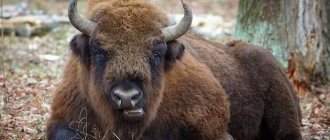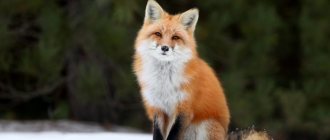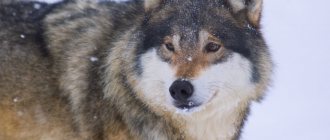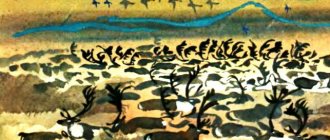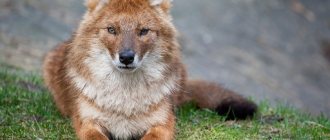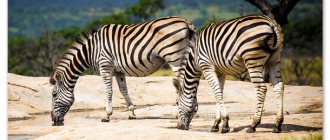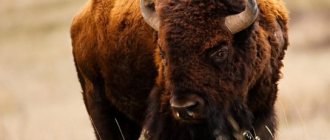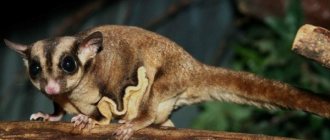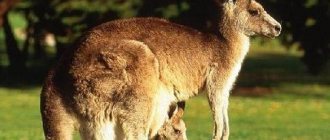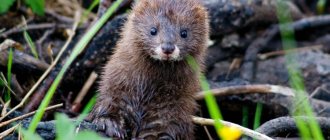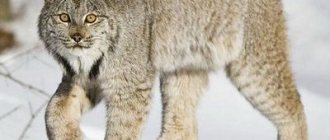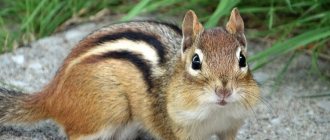The bison is an animal from the bison genus, bovine subfamily, bovid family, artiodactyl order. It is the last representative of European wild bulls. It lives in deciduous, coniferous and mixed forests in the temperate zone. The closest relative of the bison is the American bison, and when crossed with it, bison are born. In the 20s of the 20th century, the species almost disappeared from the face of the earth. All the bison that live on our planet now descended from only 12 individuals, which at the beginning of the last century were preserved on the territory of nature reserves.
Description of the bison
The bison is the heaviest and largest land mammal in Europe, although its size has decreased in recent years.
The weight of a modern adult male is 400-900 kg. Body length is about 3 m, height up to 2 m. Females are inferior in size to males: their body length is up to 2.7 m, height up to 1.7 m. — Advertisement —
The bison has a massive front part of the body, wide and high. The neck is short, the back forms a high hump on top. The chest is wider in front. The head is set low, with a wide, convex forehead, and the muzzle is small. The horns are small, protruding, black, with a smooth, polished surface. The ears are short and wide. The eyes are small with thick eyelashes. The limbs are strong, thick, shorter in front than in the back. The length of the tail is about 80 cm, at its end there is a thick brush.
The body of the bison is covered with thick hair, long and mane-like on the chest, resembling a beard in the throat and chin area. The hair on the head and forehead is curly. It is short at the back. Belovezhsky bison are grayish-brown with ocher-brown color, Caucasian bison are dark, brownish-brown with a chocolate tint. Summer fur is dark brown.
The bison has a good sense of smell and hearing, but slightly less developed vision.
Segregation of duties
To date, there are three main hypotheses regarding the participation of different hemispheres of the brain in the implementation of social functions. The first of these offers us the simplest picture: the right hemisphere plays a leading role in all major aspects of social behavior (Forrester, Todd, 2018). Indeed, there are many examples of the dominance of the right hemisphere of the brain in the control of various social reactions of humans and other mammals. Processes as diverse as the visual recognition of the sex of another individual in sheep and the perception of the odor of a male competitor in horses are carried out primarily under the control of the right hemisphere (Rosa-Salva et al., 2012). However, in some aspects of social behavior, dominance of the left hemisphere has been proven.
Many bison have unique features, such as the shape of the horns, chips and scratches on them, color and shape of the head. These features are used for individual recognition of individuals
According to another popular hypothesis, the dominance of one of the hemispheres depends on what reaction - “approach” or “avoidance” - a particular stimulus evokes in the animal (Najt et al., 2013). Thus, the left hemisphere of the brain dominates in approach reactions, and the right, respectively, in avoidance reactions. For example, it has been shown that Australian whistling crows ( Gymnorhina tibicen
), approaching a predator, they look at it with their right eye, and when they run away from it, they look back at it with their left eye (Koboroff et al., 2008).
Danio rerio
, a popular model object in studies of genetics and developmental biology, behaves in a similar way
The third hypothesis connects the dominance of the brain hemispheres with the emotional coloring of the reaction to a certain stimulus (Najt et al., 2013). This is confirmed by the results of some experimental work. Thus, when domestic dogs were presented with photographs of other dogs, then, judging by the direction of gaze, the right hemisphere was primarily involved in analyzing images with an aggressive facial expression, and the left hemisphere with a friendly expression (Racca et al., 2012). When one eye was covered in an experiment on domestic piglets, they quickly recognized positive stimuli with food reinforcement in the right eye, i.e., information was analyzed predominantly by the left hemisphere of the brain (Goursot et al., 2019).
An encephalographic study in humans also showed higher activity in the left hemisphere when perceiving positive emotions in images, and higher activity in the right hemisphere when analyzing negatively colored stimuli (Waldstein et al., 2000).
Quite a lot of examples of lateralized behavior of cetacean-toed ungulates are known today. Thus, in toothed and baleen whales, the mother prefers to keep the calf in the field of vision of her left eye (Karenina et al., 2017). Wapiti deer ( Cervus canadensis
), close to our red deer, prefer to keep individuals of their own species on their right side during rest (Found, 2016).
Male saiga antelopes ( Saiga tatarica
) often keep it in the left field of vision when pursuing an opponent, and in the right field when pursuing females (Giljov et al., 2019). Cows that are low in the herd hierarchy prefer to look at dominant individuals with their left eye, while dominant cows themselves do not have a strong unilateral preference (Phillips et al., 2015).
The bison is also no exception (Dial et al., 2008; Karenina, Giljov, 2018; Giljov et al., 2019). The size of his binocular field is small - about 60°, while the total field of vision is 300° (Andreev, 1979). With this design of the visual system, information entering the left eye is processed primarily by the right hemisphere of the brain, and vice versa. Therefore, one-sided preferences in the social behavior of bison allow us to judge not only the preference for using the left/right visual field, but also the dominance of one of the brain hemispheres in the control of a certain type of behavior.
Features of bison nutrition
The bison's diet consists of a variety of vegetation, about 400 plant species. In summer, they eat succulent grass, shoots of bushes and tree bark. In autumn, they graze mainly in oak forests, where they eat acorns. In winter, the green parts of plants are dug out from under the snow. They can also feed on mushrooms, berries, lichens and pine needles. An adult bison needs 40-60 kg of green mass and approximately 50 liters of water per day. For this reason, in winter, bison eat snow, and in summer they go to water twice a day.
Oryol Region
Status: I category. A rare species, endangered.
Distribution and abundance
On the territory of the Oryol region in 1996, work began on the reintroduction of the bison into the territory of the Oryol Polesie National Park: 12 animals were brought from the nurseries of the Prioksko-Terrasny and Central Chernozemny reserves, in 1997 - 10, in 1998 - 10, in 1999 – 14 (including from Holland), in 2000 – 16 (including from Holland, Germany, Switzerland and Belgium), in 2001 – 8 (including from Germany and Holland ).
As of January 1, 2006, the state of the bison population was estimated at 100 animals, which formed three fairly stable herds: Alekhinskoye (State NP “Orlovskoye Polesye” - Karachevsky district of the Bryansk region), Avdeevskoye (State Institution NP “Orlovskoye Polesie”) and Krasnikovskoye (State Institution NP "Oryol Polesie" - Kaluga region - GPP "Kaluzhskie Zaseki"). The annual increase is estimated at approximately 10% of the population.
Source: Red Book of the Oryol Region. Mushrooms. Plants. Animals. Ed. Kiseleva L.L., Vyshegorodskikh N.V., Prigoryanu O.M., Vyshegorodskikh N.V., Arabadzhi A.A., Vyshegorodskikh E.V. (2007) Eagle: Kovyl Center
Distribution of bison
— Advertising —
Previously, bison were distributed from the Iberian Peninsula to Western Siberia, including Great Britain. At the same time, they lived both in forests and in open areas. Due to intensive hunting, the bison population, and with it its habitat, have noticeably decreased. Now these animals are found only in Belovezhskaya Pushcha and the Caucasus.
Krasnodar region
Status: I category. In critical condition.
Spreading
The global range of the “mountain line” of bison is located in Russia and includes the upper part of the Belaya and Malaya Laba river basins, located in the Krasnodar Territory, the Republic of Adygea and, slightly, the Karachay-Cherkess Republic. The regional range of the mountain bison is limited to the upper reaches of the Malaya Laba.
Number
There are no reliable data on their numbers.
Source: Red Book of the Krasnodar Territory. Tom Animals. Ed. Zamotailov A.S. (2007) Krasnodar: PTR Development Center Krasnodar
Common types of bison
Three subspecies have been described for the bison, of which only one remains in nature, the Belovezhsky one:
- The Belovezhsky (plain) bison (Bison bonasus bonasus) previously lived from the Pyrenees to western Siberia. Larger in size than other subspecies, it also has longer legs.
- The Caucasian bison (Bison bonasus caucasicus) was common in the mountain forests of the Caucasus. Smaller in size than the Belovezhsky, the coat is dark, curly, the horns have a characteristic curve.
- The Carpathian (Hungarian) bison (Bison bonasus hungarorum) was found in Transylvania and the Carpathians.
Bison behavior
The natural habitat of the bison is forests and forest-steppes, but due to hunting, the animal went into remote places and survived only in dense forests.
Bison lead a sedentary lifestyle in a small area of forest, which they leave only in the absence of food. They live in herds of 5-20 individuals. The herd includes females and growing young; adult males live alone or in bachelor groups. The herd is led by an old, experienced female. Bison move through the forest almost silently and silently. They communicate with each other using short grunts or snorts when in danger. They move at a slow pace, go to a gallop only in dangerous situations, and can also jump. They graze in the mornings and evenings, resting during the day. Bison have good hearing and sense of smell, but poor eyesight. The character is calm, non-aggressive and not prone to attacks.
The Republic of Ingushetia
Status: 0 category. Probably a species that has disappeared from the territory of Ingushetia.
Spreading
In Ingushetia, bison were brought to the valley of the river. Assa and Fortanga, in the vicinity of the village. Upper Alkun, in 1970. Within five years, they had become well accustomed to the new place, and by 1975, some of them had settled in adjacent territories, moving to the vicinity of Bamut and North Ossetia. A total of 48 heads were imported.
Number
According to 1985 data, in Ingushetia, in the interfluve of the river. Assa and the upper reaches of the river. Fortanga was inhabited by 23–25 bison, among which there were 9–10 adult males, 10–12 females, and 3–4 young animals.
Source: Red Book of the Republic of Ingushetia: Plants. Animals. Ed. Martazanov A.M. (2007) Publishing house “Serdalo”, Magas
Bison breeding
The mating season for bison begins in August-September.
At this time, the males begin to exude a pronounced musky odor, they come close to the herds, rub against trees, dig the ground, and stand in threatening poses. They can collide with each other's foreheads or strike in the sides. In battles they often seriously injure each other. The duration of pregnancy is 9 months, calves are born in April-May. The weight of newborns is 22-23 kg, the wool is fawn in color. 1-1.5 hours after birth, the calf follows its mother, and at the age of 3 weeks it begins to try plant foods. Bison milk is very fatty (9-12%). Milk feeding can last from 5 to 12 months, but for the first two years of life, the small bison remains close to the female. Young animals reach sexual maturity at 4-6 years; in nature, life expectancy is 20-25 years (in the zoo - up to 35).
Vladimir region
Status: I category. Endangered species.
Spreading
In the Vladimir region. in 1989, the first 9 bison were released into the wild in the Vyaznikovsky district; in 1994–2007 16 more were brought here. In 2002–2004. 12 bison were released on the border of the Murom and Gorokhovetsky districts (FGPZ “Muromsky”). In the first years, adaptation of both groups was very difficult, several animals died, but over time there was a steady increase in the population. As their numbers increase, animals begin to spread to neighboring lands; for example, bison enter the northern part of Gorokhovetsky District from the Vyaznikovsky District, and enter the southern part of the Vyaznikovsky District from Muromsky District.
The free-ranging population is protected in the Muromsky Federal State Nature Reserve and the Klyazminsko-Lukhsky State Nature Reserve, and feeding is organized in the winter.
Number
At the beginning of 2022, in the Vyaznikovsky district (GPZ “Klyazminsko-Lukhsky”), 47 bison were counted (of which 5 were calves under the age of 1 year), and in the FGPZ “Muromsky” - 87 (including 16 heads offspring).
Source: Red Book of the Vladimir Region. Ed. R.E. Azbukina et al. (2010) Vladimir: Transit-ICS
Natural enemies of bison
The bison has very few natural enemies. Packs of wolves dare to attack adults, while young animals are hunted by wolves, lynxes, leopards, and bears. The main enemy for the bison is man. Previously, people hunted these animals for their meat, although its quality was low, it was tough, with a musky aroma. Only calf meat is juicy and tender. The advantage of hunting bison was their large size. Later, kings, princes, and landowners began to hunt bison for the sake of excitement and prestige. The last Caucasian and European bison in the wild were killed by poachers.
The Republic of Mordovia
Status: I category. An endangered species.
Spreading
In Mordovia, on the territory of the reserve of the same name, this species is a typical representative of mixed and deciduous forests.
Number
On the territory of the Mordovian Nature Reserve and the adjacent areas of the Temnikovsky forestry enterprise, no more than 2-3 individuals of this species live. The species may become extinct in the near future.
Source: Red Book of the Republic of Mordovia. Volume 2. Animals. Ed. IN AND. Astradamov (2005) Saransk. Mordovian book publishing house
Interesting facts about the bison
- At the time when the last bison in the wild was killed, there were about 60 individuals left in captivity. The International Society for the Conservation of Bison began breeding animals in zoos, after which a small herd was first released on the territory of the Belovezhskaya Pushcha nature reserve, and later transported to European countries. In the Caucasus, hybrids of the Caucasian bison and bison were released, which, after acclimatization, became similar to the purebred species previously common in these places. Today the bison population is about 3,000 individuals, of which approximately half live in natural conditions. Bison have never been domesticated, but they produce hybrids with bison and bulls. The latter are sterile, but unpretentious in maintenance and produce a high yield of protein-rich meat.
Vologda Region
Status: I category. Endangered species.
Spreading
5 purebred bison (1 male and 4 females) were first brought to the territory of the Vologda region from the Prioksko-Terrasny biosphere reserve (Moscow region) in 1991 and 1994. The imported bison were released into the previously surveyed territory of the Ust-Kubinsky region. As a result of a survey of the territory of the central part of the Vologda region, 552.6 thousand hectares of land were identified, including 324.8 hectares of forest land suitable for the settlement and habitat of bison.
Number
A rare species that is restoring its numbers in nature and its preservation. The emerging new free-living herd includes 20 purebred bison.
Source: Red Book of the Vologda Region. Animals. Ed. H.L. Bolotova, E.V. Ivanter, V.A. Krivokhatsky (2010) Vologda, Polygraph-Book
